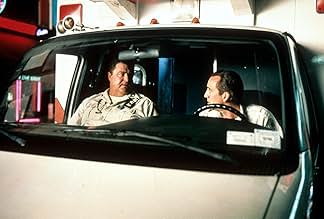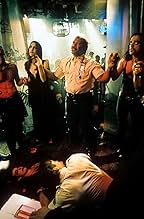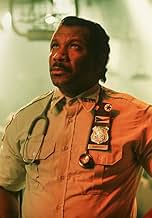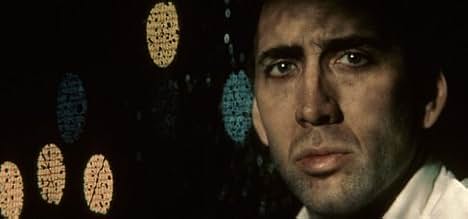Perseguitato dai pazienti che non riuscì a salvare, un paramedico di ambulanza di Manhattan estremamente esaurito combatte per mantenere la sua sanità mentale in tre notti turbolenti.Perseguitato dai pazienti che non riuscì a salvare, un paramedico di ambulanza di Manhattan estremamente esaurito combatte per mantenere la sua sanità mentale in tre notti turbolenti.Perseguitato dai pazienti che non riuscì a salvare, un paramedico di ambulanza di Manhattan estremamente esaurito combatte per mantenere la sua sanità mentale in tre notti turbolenti.
- Regia
- Sceneggiatura
- Star
- Premi
- 2 vittorie e 5 candidature totali
- Mr. Burke
- (as Cullen Oliver Johnson)
- Captain Barney
- (as Arthur Nascarella)
Recensioni in evidenza
Overall, Bringing Out the Dead appears to be heavily influenced by film noir. Frank, the protagonist, is at the end of his rope in a rather solitary and stressful job and he often finds escape from the ghosts of his failures through alcohol. Patricia Arquette plays Mary, the femme fatale character and woman in distress Frank seeks to save. The film is uber-urban, set mainly in the nighttime ghettos and hustling districts of New York City, and the major events center around various city dwellers. Frank's adventures in life saving are highlighted by the colorful characters of City life, including prostitutes, drug addicts, homeless persons, insane persons, goth-punk death rockers and the ubiquitous 'Mr. O.,' the smelliest destitute to plague Our Lady of Perpetual Mercy Hospital. Frank is led by Mary into the narcotic underworld, and meets the proprietor of 'The Oasis,' a charismatic dealer with a passion for tropical fish and silk robes.
Many of the lighting techniques also serve to emphasize the urbanality of the surroundings, often combining music and fast paced editing. The darkness of the City night is contrasted with the searing halogen of the hospital, and the sunlight that creeps through the window at dawn mocks Frank's insomnia. Indeed, the movie ends at dawn, with Frank nodding off to sleep. This is very similar to the traditional horror movie ending at dawn when the nighttime monsters are relegated to their nocturnal lairs. Editing techniques are feverish and accelerate in pace as the movie progresses and Frank's hysteria mounts. Many of these sequences involve a montage of the flashing ambulance lights, 360-degree camera rotation, blurred traffic lights and shots of the crazed driver behind the wheel. My personal favorite scene is when Frank is going to answer a call, and the montage is set to R.E.M.'s What's the Frequency Kenneth.
Overall, most of the main characters are the male ambulance drivers/EMTs. These characters, Frank, Tom, Marcus and Larry, exude a kind of unquestioned masculinity, which they prove through various means such as violence, excessive flirting, and alcohol consumption. Tom is a violent, hair trigger macho who enjoys pummeling transients and minorities. Marcus is a smooth talking black man who chain smokes stogies and praises Jesus. Larry is an overweight everyman, wanting to start his own paramedic business. Frank is a Marlboro smoking altruistic cowboy with a drinking problem and insomnia. At some point, most of the characters engage in drinking (liquor) while on duty or at least in the ambulance. The characters names are also quite masculine, especially in contrast to Noel, a man who is a drug addict of ethnic descent that is never arguably fully a man.
Inherently, Scorsese's New York City is an urban jungle that will break any man who is not strong or tough enough.
Frank tells us at the movie's outset that he hasn't saved a life in months, and that he's beginning to believe in things like spirits that leave a body and don't want to come back. He's starting to feel like a "grief mop", like his only real responsibility is to "bear witness" to death and suffering. Frank and his partner Larry (John Goodman) are attempting to resuscitate a heart attack victim as the movie begins, and as the man's daughter Mary (Patricia Arquette) looks on in horror, Larry is successful in pulling him back from death's door. The overrun hospital, however, shoves him into a corner and keeps him drugged up, shocking him back to "life" when necessary. Mary tells Frank she hadn't spoken to her father for a long while before his attack, and in fact had often wished he were dead, but that now there's nothing she'd like more that to just hear his voice again. She was once a junkie but has now been clean for months, she tells him. Frank seems moved by Mary, seems to want to "save" her -- perhaps he thinks if he can save her, he will be able to let go of the pain of losing Rose.
Frank's developing feelings for Mary provide a counterpoint to the insanity he encounters on emergency calls with his partners Larry (John Goodman), Marcus (Ving Rhames), and Walls (Tom Sizemore). Sometimes the calls involve merely picking up the local smelly drunk Mr. O, their "most frequent flier" who seems to think the hospital is a nice place to sober up. Other times they involve matters that are much more serious, like resuscitating a heroin OD in a club (a great scene) or assisting in the allegedly virgin birth of twins (haunting, and one of the movie's many examples of religious imagery). But no matter where Frank goes, he sees Roses' face -- he sees her everywhere, she comes to him in the guise of the nameless street people that cross his path.
There really is no plot to "Bringing Out The Dead", and that's a good thing because the movie isn't meant to be a straightforward narrative. It's meant to be a snapshot of a man's soul, of his inner demons, and a conventional plot would only cloud the movie's real point. The narrative thrust comes mostly from Frank's interactions with his partners -- each of them representing a different approach, a different way of dealing with the pain brought on by this nerve wracking job. Larry (Goodman) seems to be able to block out the emotional aspects of his job, he seems to see his position mainly as a means to an end, and in fact he tells Frank he'll be a captain one day. Marcus (Ving Rhames, in a scene stealing performance) puts all trust and faith in God, believing that if someone dies, it's just their time to go. Walls (a scarily effective Tom Sizemore) is a borderline psychotic, terrorizing patients (including dread locked street person Noel, well played by singer Mark Anthony) and bashing in his ambulance headlights with a baseball bat.
If these three provide the kinetic thrust of the movie, Frank and Mary provide it's emotional center. Frank finds himself drawn closer and closer to Mary, and in fact he tries to rescue her when she resorts to visiting scummy drug dealer Cy Coates (the excellent Cliff Curtis) at the Oasis, a scarily shot urban hellhole that seems to be a local haven for drug dealing. She needs some respite, however temporary and narcotic, from the pain, and in this sense she has a link with Frank (who drinks on the job and taps into his own medical supplies to get high). The movie seems to be saying that these two people need each other; perhaps each has what is needed to soothe the other's hurt.
"Bringing Out The Dead" is the fourth collaboration between Scorsese and screenwriter Paul Schrader, and it touches on their familiar themes of faith, guilt, hope, and redemption. Much has been written about the similarities between this film and "Taxi Driver", Scorsese's 1976 ode to urban rot. I feel these similarities are somewhat superficial. Though Frank and Travis Bickle are both lonely, disenfranchised, ill people, Frank wants to help people; Bickle just wants to clean the "trash" up off the streets. Bickle lashes out in rage; Frank lashes out in fear and desperation. Schrader's screenplay offers satisfying levels of complexity, so that ultimately, towards the end, when Frank does something totally unexpected and morally ambiguous, we understand exactly why he's doing it and can sympathize.
Of course, from a technical standpoint "Bringing Out The Dead" is flawless. Ace lensman Robert Richardson (who previously worked with Scorsese on "Casino") gives the city an appropriately gloomy, sick look, and his work is especially effective in a scene in which Cy dangles from a sixteenth floor balcony while fireworks explode behind him. Thelma Schoonmaker's expert editing is, as usual, outstanding -- she gives the fast paced scenes the charge they need, and provides some dizzying sped up camera effects during the emergency call scenes. Scorsese's choice of music is great, as is his work with the actors. Sizemore, Anthony, Curtis, Arquette, and especially Rhames are all good, but it's Cage who must hold the movie together, and he succeeds with a towering performance that is easily his best work since "Leaving Las Vegas". Cage is cast perfectly here; his tortured, implosive Frank Pierce is an indelible character.
"Bringing Out The Dead" is not for everyone. The movie's lack of a conventional narrative arc will probably confuse and alienate some viewers, and the way it uncompromisingly looks into the darkest corners of human nature with an unflinching eye will disturb others. Yet these qualities are Scorsese's hallmarks, and this film has links to many of his other works -- the confusion of "After Hours", the emotional indecision of "The Age of Innocence", the alienation of "Taxi Driver", the spiritual search of "The Last Temptation of Christ". "Bringing Out The Dead" is not easy to watch, and at times it's hard not to look away. But it's real, and it stays with you.
Starring: Nicolas Cage, Patricia Arquette, John Goodman, Ving Rhames, Tom Sizemore, Cliff Curtis Director: Martin Scorsese Running time: 120 minutes Rated R (for gritty violent content, language, and drug use)
By Blake French:
Martin Scorsese's "Bringing Out The Dead" is one of the only movies I have ever seen that does not remotely glamorize its subject matter. That is something that does not come naturally in the world of film. Movies glamorize almost everything they face matters with; whether it's violence, drugs, sex, or other behaviors. Movies persuade, advertise, and sell incorrect messages to hungry and excepting pedestrians. Not only is "Bringing Out The Dead" an anti-violence, drugs and glamour film, it also manages to deliver its message through one of the most talented actors in Hollywood clearly and understandably. This is one of the year's most unsettling and uncompromising productions, and also one of the year's best.
"Bringing Out the Dead" offers no story in its existence. But there is no actual need for a plot here, due to a strong, precise narrative through-line and focused point of view seen through its central character. He is Frank Pierce (Nicolas Cage), who narrates the film with a sense of depravity. He and his buddies, Marcus (Ving Rhames), Tom (Tom Sizemore), and Larry (John Goodman), work the evening shift at New York's Hell's Kitchen as Ambulance Drivers for an emergency hospital. They live a life full of stress, sweat, and desperation. Frank often comes to work pleading for his boss to fire him. The opening scene, which properly induces the desperate and gritty lives of the main characters, features Frank and Larry, being called to the home of Mary Burke, whose unhealthy father is having a heart attack. They stabilize him, rush the man to their emergency care facility, and go on with their lives.
Now, where many "lesser" movies would have developed a romantic subplot with the Mary character and Frank, "Bringing Out the Dead" is too focused and skillful to do that. There is affection between the two. But Frank is in such a position in his life that he just isn't prone to fall for a woman. Nor does he give in to any of the many hookers standing on the street blocks tempting him to keep them in business. He is on the verge of an nervous break down, and the film never pretends otherwise.
While for the most part, this movie didn't give into any major distractions or side-subjects, it did have several flawed and unexplained subplots. The story featuring Frank constantly being haunted by the ghost of a young girl he lost some time ago isn't really explained enough. Nor does an unusually bizarre scene later on payoff featuring Frank saving lost souls in pain beneath the streets of New York. And there seems to be an extremely dangerous drug featured in the movie, which strangely appears at the overdoes scenes where Frank is called to--this isn't detailed enough to pay off either. I do realize the purpose of us not knowing about this medical issue; we don't have the knowledge because Frank doesn't. But I still think there may have been a way to inform the audience on the context of this material, without making the hero look stupid. Also, the film is over narrated by Frank, who sometimes describes his interesting past experiences through words, not flashbacks or visions, which would have been much more intriguing.
Scorsese makes no sense of the chaotic, unorganized, unsettling medical experiences patients go through in the emergency room where Frank doctors in. The style he uses to depict the film in is flawless in this justification: the camera angles are mind-warping and fast paced, the atmosphere of the movie is gritty, with blood and vulgarism abound. The characters pace frantically as they travel across one end of the building to the next, not sure to where or whom they are going. The characters also are injected with a deep sense of lifeless scrounge, as they stare and gaze into each other's eyes, only to discover there is nothing in each other. In some aspects, this film is like "Saving Private Ryan": a tantalizing hell.
And Nicolas Cage delivers yet another fascinating performance here. His character is empathized with the entire way through, even if narration is used instead of illusion. He manages to depict his character through the torment and emotional damnation required. He pursues profoundness in scenes where his character realizes happiness in itself. "I fell like I saved someone," mutters Frank to himself. Good job, Frank. You saved yourself.
Brought to you by Paramount Pictures and Touchstone Pictures.
The role of a mentally unbalanced individual tormented by what he's seen and done is a natural for the talented Cage. Here Cage shows just how good he can be when working with strong material. (Although that's not to say that he doesn't have some VERY intense moments.) Scorsese is to be commended for his impressive use of surrealism, and the grim, seedy aesthetic he often applies to the film. It has great atmosphere, and equally fine use of locations.
The story is episodic in nature, as we see Frank work with a succession of partners: the amiable John Goodman (as Larry), an upbeat and energetic Ving Rhames (as Marcus), and a lively Tom Sizemore (as Tom Wolls). The whole cast does creditable work, and there are a pleasing number of familiar faces and reliable character actors and actresses in supporting roles: Marc Anthony, Mary Beth Hurt, Cliff Curtis, Nestor Serrano, Aida Turturro, Sonja Sohn, Afemo Omilami, Arthur J. Nascarella. Scorsese can be heard as a male dispatcher, Queen Latifah is the voice of a female dispatcher, and that's independent filmmaker Larry Fessenden in a cameo as a cokehead.
With a very eclectic soundtrack as accompaniment, striking cinematography by Robert Richardson, and some dizzying camera angles, "Bringing Out the Dead" proves to be an interesting, provocative, and heartfelt depiction - albeit with memorable comedic elements - of the grim side of life in NYC. Ultimately, it's a long, hard road to finding the strength and faith that Frank needs to carry on.
Eight out of 10.
What Scorsese Film Ranks Highest on IMDb?
What Scorsese Film Ranks Highest on IMDb?
Lo sapevi?
- QuizAccording to Tom Sizemore, he and Marc Anthony did not get along and almost had a physical altercation on the set.
- BlooperWhen Marcus and Frank are responding to I.B. Bangin's over-dose, they are first shown responding in a van-type ambulance, then the next shot shows them in a box-type, then back to the van-type on arrival.
- Citazioni
Frank Pierce: Saving someone's life is like falling in love. The best drug in the world. For days, sometimes weeks afterwards, you walk the streets, making infinite whatever you see. Once, for a few weeks, I couldn't feel the earth - everything I touched became lighter. Horns played in my shoes. Flowers fell from my pockets. You wonder if you've become immortal, as if you've saved your own life as well. God has passed through you. Why deny it, that for a moment there - why deny that for a moment there, God was you?
- Colonne sonoreT.B. Sheets
Written and Performed by Van Morrison
Courtesy of Columbia Records
By Arrangement with Sony Music Licensing
I più visti
- How long is Bringing Out the Dead?Powered by Alexa
Dettagli
- Data di uscita
- Paese di origine
- Lingua
- Celebre anche come
- Vidas al límite
- Luoghi delle riprese
- Aziende produttrici
- Vedi altri crediti dell’azienda su IMDbPro
Botteghino
- Budget
- 55.000.000 USD (previsto)
- Lordo Stati Uniti e Canada
- 16.797.191 USD
- Fine settimana di apertura Stati Uniti e Canada
- 6.193.052 USD
- 24 ott 1999
- Lordo in tutto il mondo
- 16.798.496 USD
- Tempo di esecuzione2 ore 1 minuto
- Colore
- Mix di suoni
- Proporzioni
- 2.39 : 1
Contribuisci a questa pagina






































